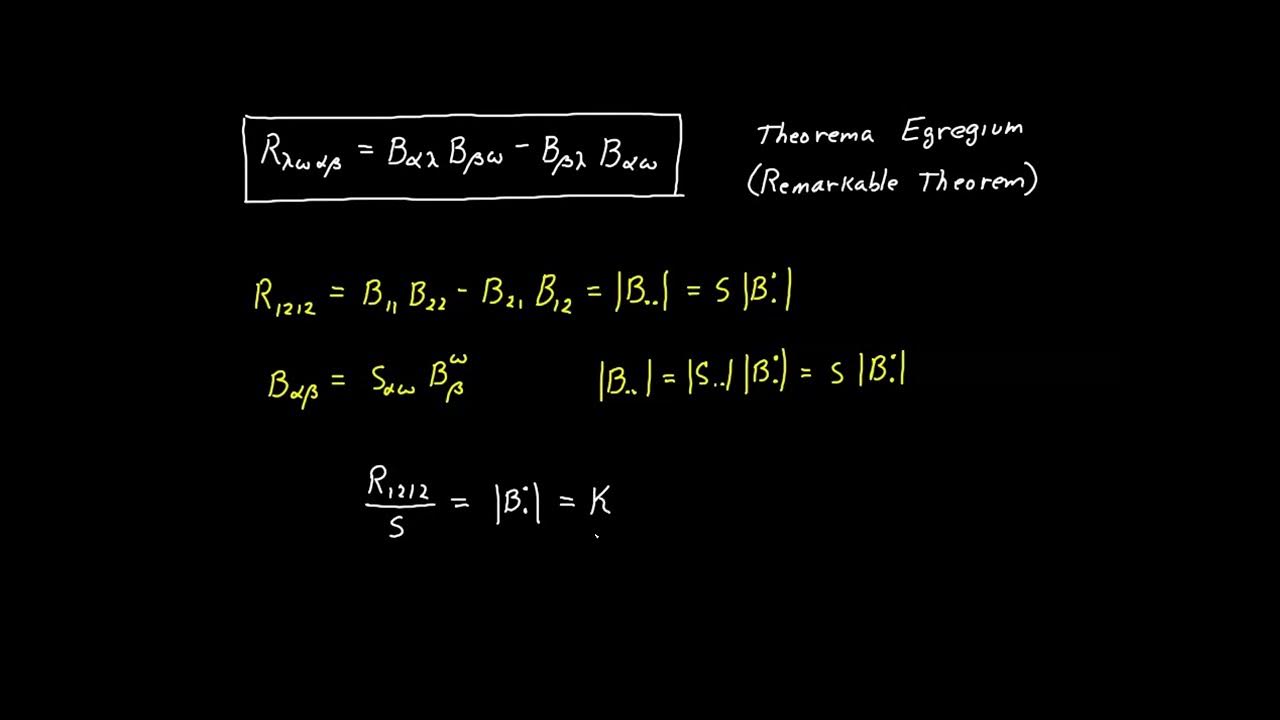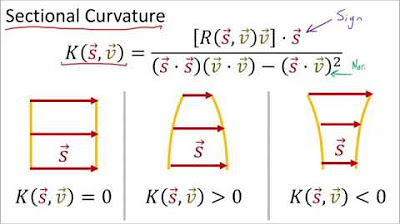Video 82 - Riemann Christoffel Tensor
TLDRThis video introduces the Riemann curvature tensor, a fundamental tool in tensor calculus for measuring the intrinsic curvature of a manifold. The script explains the process of applying the commutative operator to a contravariant vector component, leading to the definition of the Riemann tensor. It also covers the transformation of the tensor from having one upper index and three lower indices to all indices being in the lower position, emphasizing the tensor's role in understanding manifold curvature.
Takeaways
- 📚 The Riemann Christoffel tensor, commonly known as the Riemann tensor, is introduced as the primary tool for quantifying manifold curvature intrinsically.
- 🔍 The covariant derivative is an operation that commutes in flat manifolds but not in curved ones, which is expanded upon to define the Riemann tensor.
- 📐 The script explains the process of taking the covariant derivative of a tensor with respect to two variables, and the significance of the order of operations.
- 🔑 The Riemann tensor is defined as a fourth-rank tensor with one upper index and three lower indexes, and its role in tensor calculus is highlighted.
- 📝 An alternate, more concise form of syntax for the covariant derivative operation is introduced without changing its meaning.
- 🧩 The process of eliminating intermediate tensor components by referencing the full definition is detailed, simplifying the expression to its final form.
- 🔄 The script walks through the cancellation of terms in the expanded expression, resulting in a simplified form of the Riemann tensor.
- 🔢 The quotient theorem is used to confirm that the resulting expression is indeed a tensor, due to the operations performed on tensors.
- 🔄 The video script also covers how to lower the index of the Riemann tensor to have all four indexes in the lower position for alternative representation.
- 📉 The final expression for the Riemann tensor with all indexes lowered is derived, which is crucial for certain mathematical manipulations and applications.
- 🚀 The video concludes with a preview of upcoming content, which will explore the properties and applications of the Riemann tensor in more depth.
Q & A
What is the primary purpose of the Riemann tensor in the context of tensor calculus?
-The Riemann tensor is used to quantify the curvature of a manifold from an intrinsic perspective, providing a way to measure how the covariant derivative does not commute in curved spaces.
What is the difference between a tensor and an operation in tensor calculus?
-A tensor is a mathematical object that can be manipulated in tensor calculus, while an operation is a process performed on tensors. The covariant derivative is an example of an operation, not a tensor itself.
How does the covariant derivative operation relate to the curvature of a manifold?
-The covariant derivative operation reveals the curvature of a manifold through its non-commutative property. When applied in different orders to a tensor, the results differ in curved manifolds, indicating curvature.
What is the initial form of the Riemann tensor in terms of its indices?
-The initial form of the Riemann tensor is a fourth-rank tensor with one upper index and three lower indices.
Why is it sometimes useful to have all indices of the Riemann tensor in the lower position?
-Having all indices in the lower position can be more convenient for certain calculations and manipulations, depending on the context of the problem being solved.
How does the quotient theorem confirm that the result of the commutative operation is a tensor?
-The quotient theorem states that if the covariant derivative of a tensor is taken and then another derivative of that result, the final expression obtained after subtraction is also a tensor due to the properties of tensor operations.
What is the significance of the Christoffel symbols in the definition of the Riemann tensor?
-Christoffel symbols are crucial in the definition of the Riemann tensor as they contribute to the terms that define how the tensor measures the curvature of the manifold.
What is the process of lowering an index in a tensor and why is it important in the context of the Riemann tensor?
-Lowering an index involves contracting a tensor with the metric tensor to move an upper index to a lower position. This is important for the Riemann tensor as it allows for alternative representations that might be more suitable for specific calculations.
How do the terms in the expanded expression of the Riemann tensor simplify after considering index symmetries and cancellations?
-Many terms cancel out due to symmetries and the commutative property of partial derivatives. After cancellations, only a few unique terms remain, simplifying the expression of the Riemann tensor.
What is the final expression for the Riemann tensor with all indices in the lower position, and how is it derived?
-The final expression is derived by lowering the upper index using the metric tensor and partial derivatives, and then simplifying the expression by considering index symmetries and cancellations.
Outlines
📚 Introduction to the Riemann Curvature Tensor
This paragraph introduces the Riemann curvature tensor, a fundamental concept in tensor calculus used to measure the intrinsic curvature of a manifold. The video discusses the covariant derivative's behavior in flat versus curved manifolds, setting the stage for a deeper exploration of the Riemann tensor. The covariant derivative is an operation rather than a tensor itself, and the paragraph explains the expansion of an expression involving the covariant derivative in two different orders, highlighting the difference between these operations as a means to quantify curvature.
🔍 Expanding the Commutator of Covariant Derivatives
The second paragraph delves into the process of expanding the expression for the commutator of covariant derivatives, which involves taking the covariant derivative of a tensor with respect to two different variables and then subtracting the results. The process begins with taking the partial derivative and adding terms involving the Christoffel symbols to account for the curvature of the manifold. The paragraph explains the step-by-step algebraic manipulations required to simplify the expression and prepare for the definition of the Riemann tensor.
📉 Simplifying the Riemann Tensor Expression
This paragraph focuses on simplifying the expanded expression for the Riemann tensor by canceling out terms that are identical or have opposite signs due to the symmetry properties of the Christoffel symbols and the order of differentiation. The process involves careful consideration of the dummy and free indices in the tensor expressions, leading to a more manageable form of the Riemann tensor with only four distinct terms. This simplification is crucial for understanding the tensor's role in describing curvature.
🔄 Lowering the Riemann Tensor's Index
The fourth paragraph discusses the process of lowering the index of the Riemann tensor from an upper to a lower position, which is sometimes more convenient for calculations. The paragraph explains the need to contract the tensor with the metric tensor to achieve this, with special attention to the handling of partial derivatives, which differ from covariant derivatives in this context. The video corrects a common mistake found in some texts and provides the correct terms needed to lower the index properly.
🌐 Final Expression and Recap of the Riemann Tensor
The final paragraph presents the final expression for the Riemann tensor with all indices in the lower position and provides a recap of the video's main points. It summarizes the process of applying the commutative operator to a contravariant vector component by forming a contraction with the Riemann tensor. The paragraph also mentions the upcoming exploration of the Riemann tensor's properties in future videos, emphasizing the tensor's importance in understanding manifold curvature.
Mindmap
Keywords
💡Riemann Tensor
💡Covariant Derivative
💡Manifold
💡Curvature
💡Christoffel Symbols
💡Commutative Operator
💡Tensor
💡Partial Derivative
💡Contravariant Vector
💡Metric Tensor
💡Quotient Theorem
Highlights
Introduction of the Riemann tensor, used to quantify manifold curvature from an intrinsic perspective.
Explanation of how the covariant derivative does not commute on curved manifolds, leading to the creation of a tensor.
The operator discussed is not a tensor itself but performs an operation that produces a tensor.
Covariant derivative of a first-rank tensor creates a second-rank tensor, as demonstrated through the operation on T lambda.
The expression U lambda beta is defined to emphasize that the operation creates a second-rank tensor.
Detailed breakdown of the covariant derivative with respect to alpha and beta, leading to the expansion of the expression.
Identification of how the Riemann tensor is formed by subtracting two commutative operations.
Demonstration of the cancellation of terms during the subtraction process, simplifying the final expression.
Final expression reveals that only four terms remain after cancellation, leading to the definition of the Riemann-Christoffel tensor.
Introduction of an alternate syntax form for the operation, offering a more concise representation.
Explanation that the Riemann-Christoffel tensor is a fourth-rank tensor with one upper and three lower indices.
Procedure to lower the upper index of the Riemann tensor, converting it to a form where all four indices are in the lower position.
Clarification that the final expression defines the Riemann tensor with all four indices in the lower position.
Assertion that the quotient theorem confirms the Riemann tensor as a tensor due to the tensorial nature of the covariant derivatives.
Preparation for further exploration of the properties and applications of the Riemann tensor in subsequent videos.
Transcripts
Browse More Related Video

Tensor Calculus Lecture 8e: The Riemann Christoffel Tensor & Gauss's Remarkable Theorem

Video 86 - Theorema Egregium

Tensor Calculus 23: Riemann Curvature Tensor Components and Symmetries

Tensor Calculus 22: Riemann Curvature Tensor Geometric Meaning (Holonomy + Geodesic Deviation)

Tensor Calculus Lecture 6c: The Covariant Derivative 2

Tensor Calculus 24: Ricci Tensor Geometric Meaning (Sectional Curvature)
5.0 / 5 (0 votes)
Thanks for rating: